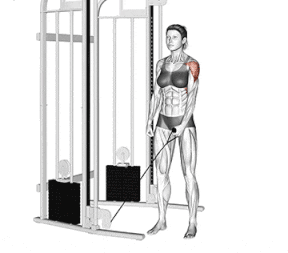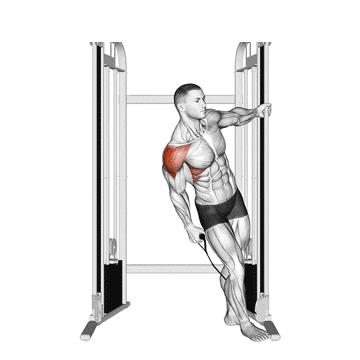The one-arm cable lateral raise is a variation of the traditional lateral raise exercise that utilises a cable machine instead of dumbbells. This exercise works the lateral (or “middle”) deltoid muscle in the shoulder.
Cable machine exercises provide a steady and consistent amount of resistance throughout the whole range of motion. This can make the exercise more challenging and lead to better muscle activation than free-weight exercises.
You can do this exercise with both arms, but it’s usually best to do it with just one arm to make your workout more challenging and effective. It helps create balanced shoulder development between the sides.

- One Arm Cable Lateral Raise Muscles Worked
- How To Do Single-Arm Cable Lateral Raise
- Form and Tips
- Single Arm Leaning Cable Lateral Raise
- How To Do Leaning Cable Lateral Raise
- Tips and Form
- Modifications To One Arm Cable Lateral Raise
- FAQ
- How do single-arm lateral raises work?
- How do you do lateral raises on cable one arm?
- Is one arm lateral raise better?
One Arm Cable Lateral Raise Muscles Worked
The one-arm cable lateral raise mainly targets the deltoid muscles.
- Primary Muscle Worked: Lateral Deltoid (Middle Deltoid)
- Secondary Muscles, Stabilizers and Synergists: Anterior Deltoid (Front Deltoid), Trapezius, Supraspinatus, Infraspinatus, Teres Minor, and Core Muscles (the rectus abdominis, obliques)

How To Do Single-Arm Cable Lateral Raise
- Attach a single handle to a low pulley on the cable machine.
- Stand perpendicular to the machine, with your feet shoulder-width apart.
- Grab the handle with the hand furthest from the machine. Your palms should be facing slightly toward the inside of your outer leg (slight pronation).
- Your arms should be straight, and your elbows should be slightly bent. All repetitions should start in this position.
- While keeping your abs engaged, raise the handle out to your side.
- Continue lifting until your arm is parallel or slightly above parallel to the ground.
- Pause at the movement’s top, then slowly lower back down to your legs like you lifted them.
- Do at least 10–15 reps per set for each arm. Repeat on the other side.
Form and Tips
- Focus on keeping your shoulder blades down and back to avoid shrugging your shoulders.
- Keep your torso still, your back straight, and your elbow slightly bent.
- Don’t swing the dumbbell; keep the movement slow and controlled. If you need momentum to lift the dumbbell, you’re probably using too heavy a load.
- Always use weights that you can handle comfortably.
- Allow the arms to move freely but don’t lock out the elbows.
- Use a slightly slower eccentric than usual to maintain more tension through the side delts.
- Exhale as you lift the weight and inhale as you lower it to help maintain proper form and breathing.
- Perform anywhere from 10-15 reps per set and 3-4 set of one arm cable lateral raise.
- If you are performing fewer than 10 reps, you are likely using too much weight and relying on muscles other than your shoulders to lift the weight.

Single Arm Leaning Cable Lateral Raise
The Leaning Cable Lateral Raise is a variation of the traditional cable lateral raise. The main difference is that you lean away from the machine, creating a diagonal angle between your body and the cable.
When you lean away from the cable machine, you will increase the tension on the lateral deltoid.
In this position, your shoulders have to work harder to lift the weight, which helps improve muscle fibre recruitment and, ultimately, better shoulder development.
The leaning position also naturally limits your ability to use body momentum to swing the weight up. This enforces a stricter form and more focused deltoid activation.
How To Do Leaning Cable Lateral Raise

- Attach a single handle to the low pulley of a cable machine.
- Hold the handle with the hand farthest from the machine. Keep your feet together.
- Hold onto the machine with your free hand and lean your body away from the machine until your arm is fully extended and the cable is taut. Your body should form a straight line from your feet to your head.
- Your working arm should be extended down by your side, with a slight bend in the elbow.
- Exhale as you raise your arm up to the side until it is parallel to the floor. Keep your elbow slightly bent and your palm facing down.
- Briefly pause at the top of the movement to maximize the contraction in your lateral deltoid.
- Inhale as you slowly lower the handle back to the starting position with control. Avoid letting the weight drop too quickly.
- Do 3-4 sets of 12-15 reps on each arm.
Tips and Form
- Maintain a slight bend in your elbow (about 10-15 degrees). This reduces stress on the elbow joint and keeps tension on the deltoid muscle.
- Avoid excessive leaning. The goal is to create a slight angle without compromising your posture.
- Only lift your arm to shoulder height. Going higher can shift tension away from the lateral deltoid and engage other muscles, such as the upper traps.
- Retract and depress the scapula (pull shoulders back and down) to stabilise the shoulder joint.
- Start with a manageable weight to master the form before progressing to heavier loads.
- Keep your wrist in a neutral position to avoid unnecessary strain and maintain proper force direction through the arm.
Modifications To One Arm Cable Lateral Raise
You can make a couple of modifications when performing one-arm cable lateral raises.
One modification you can make when performing one-arm cable lateral raises is to turn your wrist and point your thumb down towards the ground, as if you are pouring water out of a pitcher, as you lift the weight.
You can also make a second modification when performing one-arm cable lateral raises by positioning your arm differently at the start of the exercise. For example, you could start with your arm in front of or behind your body.
The third modification is the lateral lean raise, which helps isolate the lateral deltoid and allows it to move through a more expanded range of motion.
FAQ
How do single-arm lateral raises work?
The single-arm lateral raise is a shoulder exercise that targets the middle head of the deltoid muscle. It’s a fundamental strength-training move and is a great option to work on your deltoid muscle.
How do you do lateral raises on cable one arm?
One-arm cable lateral raises are performed using a single handle attachment on the low cable pulley system. You will find this in nearly all gyms.
Is one arm lateral raise better?
The one-arm lateral raise is a unilateral exercise, the best option for training the deltoid muscles. The primary benefit of unilateral exercises is their ability to train both sides of the body evenly.
It helps to avoid overuse, overtraining, or compensating with the dominant side. This can help isolate and correct muscle imbalances, which in turn can prevent injury and facilitate rehabilitation.

Manish is a NASM-certified fitness and nutrition coach with over 10 years of experience in weight lifting and fat loss fitness coaching. He specializes in gym-based training and has a lot of knowledge about exercise, lifting technique, biomechanics, and more.
Through “Fit Life Regime,” he generously shares the insights he’s gained over a decade in the field. His goal is to equip others with the knowledge to start their own fitness journey.
